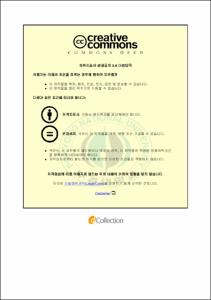순환운동이 비만중년여성의 여성호르몬, 혈중지질 및 신체조성에 미치는 영향
- Abstract
- Effect of Circulation Exercise on the Body Composition, Blood Lipide and Estrogen Hormone in Obese Middle-aged Women
Kim, Min Sub
Department of Physical Education
The Graduate School
Pukyoung National University
Directed by Professor Shin, Koun Soo, ph. D
Abstract
Background : This study is supposed to offer data related to whether circulation training (aerobic and anaerobic exercise) focused on overweight women has positive effects on reducing fat and increasing muscles for middle-aged women.
Objectives : This study aims to investigate how the circulation training affect overweight middle-aged women's female hormone, blood lipid and physical formation, which offers basic data of exercise program to keep the overweight middle-aged women healthy.
Methodology : Participants for the study are 30 to 45-year-women who were willing to take part in a M Sports Diet Program in G gu, B metropolitan city, did not have any disease. They were 29 overweight women and showed more than 30% of body fat percentage. Female hormone, blood lipid and physical formation were measured twice before and in 12 hours after exercise.
Results : The results obtained from this study are given as in the following:
1. Estrogen hormone
1) Although estrogen has meaningfully(p< .001) increased after the circulation training , there was no meaningful difference from the control group. After 12-weeks-circulation training, even though there were no meaningful differences between groups before the training, the circulation training group was meaningfully(p< .01) higher than the control group.
2. Blood lipid
1) Although TC has meaningfully(p< .001) increased after the circulation training, there was no meaningful difference from the control group. When it comes to groups, the circulation training group was meaningfully (p< .01) higher than the control group.
2) Even though TG has meaningfully(p< .01) increased after the circulation training, there was no meaningful difference from the control group. When it comes to groups, the circulation training group was meaningfully (p< .05) higher than the control group.
3) Even though HDL-C has meaningfully(p< .001) increased after the circulation training, there was no meaningful difference from the control group. When it comes to groups, the circulation training group was meaningfully (p< .05) higher than the control group.
4) Even though LDL-C has meaningfully(p< .01) increased after the circulation training, there was no meaningful difference from the control group. When it comes to groups, the circulation training group was meaningfully (p< .01) higher than the control group.
3. Physical formation
1) Although weight has meaningfully(p< .01) decreased after the circulation training, there was no meaningful difference from the control group. When it comes to groups, the circulation training group was meaningfully (p< .05) lower than the control group.
2) Although the quantity of body fat has meaningfully(p< .01) decreased after the circulation training, there was no meaningful difference from the control group. No meaningful differences were shown between groups.
3) Although the quantity of lean mass has meaningfully(p< .001) increased after the circulation training, there was no meaningful difference from the control group. When it comes to groups, the circulation training group was meaningfully (p< .05) higher than the control group.
4) Although the percentage of body has meaningfully(p< .001) decreased after the circulation training, there was no meaningful difference from the control group. When it comes to groups, the circulation training group was meaningfully (p< .01) lower than the control group.
- Issued Date
- 2014
- Awarded Date
- 2014. 8
- Type
- Dissertation
- Publisher
- 부경대학교
- Affiliation
- 대학원
- Department
- 대학원 체육학과
- Advisor
- 신군수
- Table Of Contents
- 목 차
Ⅰ. 서 론 1
1. 연구의 필요성 1
2. 연구의 목적 4
3. 연구의 문제 4
4. 연구의 제한점 4
5. 용어의 정의 5
Ⅱ. 이론적 배경 7
1. 순환 운동의 특징 7
2. 중년 여성의 특징 8
3. 순환운동과 여성호르몬 9
4. 순환운동과 혈중지질 10
5. 순환운동과 신체조성 12
Ⅲ. 연구방법 14
1. 연구대상 14
2. 측정도구 14
3. 측정항목의 선정 15
4. 측정방법 15
5. 실험계획 및 방법 17
6. 자료처리 19
Ⅳ. 연구결과 20
1. 여성호르몬 20
1) 에스트로겐의 변화 20
2. 혈중지질 22
1) TC의 변화 22
2) TG의 변화 24
3) HDL-C의 변화 25
4) LDL-C의 변화 27
3. 신체조성 29
1) 체중의 변화 29
2) 체지방량의 변화 31
3) 제지방량의 변화 33
4) 체지방률의 변화 35
Ⅴ. 논 의 37
1. 여성호르몬 변화 37
2. 혈중지질 변화 39
3. 신체조성 변화 41
Ⅵ. 결 론 43
1. 여성호르몬 43
2. 혈중지질 43
3. 신체조성 44
참고문헌 46
- Degree
- Master
- Files in This Item:
-
-
Download
 순환운동이 비만중년여성의 여성호르몬, 혈중지질 및 신체조성에 미치는 영향.pdf
기타 데이터 / 883.61 kB / Adobe PDF
순환운동이 비만중년여성의 여성호르몬, 혈중지질 및 신체조성에 미치는 영향.pdf
기타 데이터 / 883.61 kB / Adobe PDF
-
Items in Repository are protected by copyright, with all rights reserved, unless otherwise indicated.